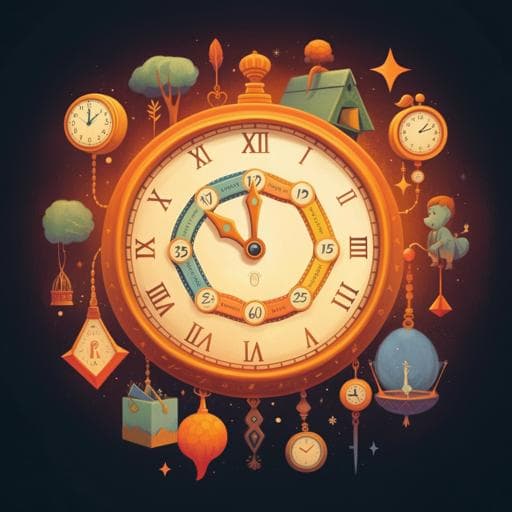
Education
Design and assessment of a teaching program to address temporal concepts in Early Childhood Education and Primary Education using stories
V. Vivas-moreno, P. Miralles-martínez, et al.
Discover how Verónica Vivas-Moreno, Pedro Miralles-Martínez, and Cosme Jesús Gómez-Carrasco developed an engaging teaching program designed to enhance temporal concepts among third-year Early Childhood Education students through the beloved story, 'Ramona la mona'. Their findings showcase effective teaching methods that bridge the understanding of time.
~3 min • Beginner • English
Introduction
The study addresses whether young children (ages 5–6) can learn temporal concepts in Social Sciences and identifies teaching approaches suitable for Early Childhood Education. Grounded in debates that historically questioned preschoolers’ capacity to grasp time and history, the paper situates temporal learning as foundational for cognitive development and navigation of social contexts. Leveraging evidence that stories enhance motivation and comprehension in early years, the research asks if temporal concepts (past/present/future, before/after, change/transformation) can be effectively taught using a non-specific children’s story, aiming to design, implement, and evaluate such a program in two third-year Early Childhood classrooms.
Literature Review
The review traces the evolution of Social Sciences teaching in Early Childhood Education, challenging earlier Piagetian interpretations that limited young children’s temporal understanding. Studies (e.g., Calvani, Cooper) show children as young as 3–6 possess temporal notions and can engage with historical thinking. Research underscores the importance of teaching temporal categories, measurement, and narratives at this stage, though practical classroom studies remain scarce. The literature highlights stories as powerful educational tools that increase motivation, support comprehension across subjects (including science and human rights), and facilitate understanding of temporal, spatial, and social aspects. Empirical work shows narrative-based programs can foster early historical thinking and related social science concepts, supporting the study’s use of a non-specific story to teach temporal concepts.
Methodology
Design: Mixed-methods study using the CIPP evaluation model (Context, Input, Process, Product), adapted for an educational program.
Context and participants: Implemented in a public Early Childhood and Primary Education Center (San Miguel) in Molina de Segura, Region of Murcia, Spain. Two third-level Early Childhood classes (A and B) participated, totaling 47 students aged 5–6. Classes included students with ASD/Asperger’s, supported by specialists. Ethical approvals were obtained from school leadership, teachers, and parents.
Study design (CIPP):
- Context evaluation: Initial Questionnaire on Temporal Concepts (IQTC) for teachers; assessment of spatial and material resources.
- Input evaluation: Design of a teaching program using the non-specific story “Ramona la mona” (Carrasco, 2006), aligning with regional curriculum objectives; selection of methods, timing, and materials tailored to student needs and classroom resources.
- Process evaluation: Implementation across initial, continuous, and final assessments. Initial assessment via brainstorming to elicit prior knowledge. Continuous assessment through student artifacts (drawings, worksheets, masks), direct and systematic observation, and field notes via voice recordings. Final assessment via individual temporal murals and hypothesis verification about the story.
- Product evaluation: Analysis of results from recordings and a Final Self-assessment Questionnaire (FSQ) completed by teachers.
Intervention content and objectives: Focused on temporal concepts (before/after, past/present/future, change/transformation) via the human life cycle (baby–child–adult–elder); development of oral communication norms; valuing personal and peers’ work.
Method: Mixed methodology combining group activities (circle time, collaborative tasks) with individual work followed by whole-group presentations to maintain classroom routines and leverage participatory learning benefits.
Activities sequence (April 2019):
1) Motivation and prior knowledge (brainstorming on temporal concepts).
2) Hypothesis generation and narration of “Ramona la mona” using a custom EVA foam, velcro-based book; individual favorite-scene drawings; play with story materials.
3) “Bruno’s family is going on a trip!” ordering characters by age on a train worksheet (youngest to oldest) to practice before/after and past–present ordering.
4) “What were we like when younger?” students present baby photos; discuss past habits and changes.
5) “What did we do before and what are we doing now?” class lists under Past vs Present.
6) “What will we be like when older?” individual future self-portraits; compilation into “When we get older...” book.
7) Making grandparent masks; FaceApp demonstration to visualize aging.
8) Temporal murals (Past/Present/Future) assembling photos/images; verification of story hypotheses from Activity 2; presentation of the compiled future drawings book.
Data collection tools: Ad hoc checklists, observation scales, systematic observation protocols, voice recordings, student work artifacts; IQTC (teachers) and FSQ (program self-assessment). Brainstorming transcripts created as primary text.
Data analysis: Quantitative analysis of checklisted observations and artifacts using SPSS v24 (percentages, frequencies). Qualitative analysis using ATLAS.ti 7.5.2, following Miles and Huberman’s approach with thematic coding, mixed deductive–inductive category development, and axial coding to build semantic networks (IQTC, FSQ, brainstorming).
Key Findings
- Context/IQTC: Both teachers emphasized the importance of temporal concepts and reported teaching them using stories and image sequences, with similar strategies and activities but differences in spatial organization and grouping.
- Initial assessment (brainstorming): Class A provided more varied examples for Past (recent and distant) and more specific examples for After; no significant differences between classes for Present, Future, or Before.
- Continuous assessment (artifacts and behaviors):
• Story drawings correctly completed: 100% (Class A) vs 95.7% (Class B).
• Future drawing correctly completed: 82.6% overall (both classes).
• Ordering worksheet (train coaches youngest→oldest): 85.7% (A) vs 87% (B).
• Grandparent mask with future references: 78.3% (A) vs 52.2% (B).
• Behavioral indicators: raised hands to speak 100% (A) vs 69.6% (B); turn-taking 91.7% (A) vs 76.9% (B); keeping quiet/listening 79.2% (A) vs 76.9% (B); making hypotheses 45.8% (A) vs 56.5% (B); remembered story characters 100% (both). Class A showed higher overall participation rate; Class B’s participating students contributed more frequently; Class B exceeded Class A notably in Activity 5.
- Final assessment (temporal murals): Correct placement—Past: 83.3% (A) vs 73.9% (B); Present: 79.2% (A) vs 73.9% (B); Future: 87.5% (A) vs 91.3% (B). Differences were non-significant, with Class A slightly higher for past/present and Class B slightly higher for future.
- FSQ (product evaluation): Strengths included motivational nature, appropriate objectives/content aligned with curriculum, flexible and feasible use of typical classroom resources, suitable mix of individual and group work, and effective data tools (ATLAS.ti, SPSS). Areas for improvement: better time estimation (e.g., split Activity 4 into two sessions), address comprehension issue noted in Activity 3, include more activities targeting the Present concept, and either remove or teach change/transformation with more specific, dedicated activities.
- Resource context: Center had sufficient general resources; many newer technological tools were out of order; a digital blackboard was available for part of one activity.
Overall: High rates of objective fulfillment across activities in both classes, supporting that targeted temporal concepts can be taught using a non-specific story.
Discussion
Findings directly address the research question by demonstrating that preschoolers can learn and apply temporal concepts (past/present/future, before/after, change/transformation) through a narrative-centered program using a non-specific children’s story. Quantitative results across artifacts and murals, along with observed behaviors, indicate substantial understanding and application of temporal sequencing and distinctions. Differences between classes align with minor methodological and organizational variations reported by teachers, suggesting classroom context and grouping strategies may influence specific outcomes (e.g., future references in masks, participation patterns). The program’s motivational design and integration of imagination and dramatization resonate with literature emphasizing the efficacy of stories and fantasy in early social science learning. The results corroborate prior evidence that children aged 3–6 possess and can extend temporal notions, and that narrative approaches effectively support conceptual development in Early Childhood Education. Recommendations from the FSQ (e.g., expanding present-focused tasks and deepening change/transformation content) refine future iterations and highlight areas where temporal concepts may require additional scaffolding.
Conclusion
- Teachers value temporal concepts and actively teach them in Early Childhood Education using narratives and visual sequences.
- The designed program, centered on the non-specific story “Ramona la mona,” effectively taught temporal concepts to third-year Early Childhood students, with high rates of correct performance in activities and final murals across two classes.
- Class A generally showed slightly higher prior knowledge and performance for past/present, while Class B showed a slight advantage in future-related tasks; differences were not significant overall.
- The program is feasible and motivational using common classroom resources; however, time management should be improved, and content on change/transformation should be either removed or addressed more explicitly with targeted activities. Additional tasks focusing on the Present concept are recommended.
- The study supports narrative-based instruction as an effective approach for foundational Social Sciences learning in early years and provides a replicable, adaptable program for similar contexts.
Limitations
- Implementation constraints included time limitations that compressed the schedule and required splitting certain activities (e.g., Activity 4 recommended to be delivered over two sessions).
- Technological resources: many newer devices at the center were out of order, limiting the use of technology (only partial use of a digital blackboard in one activity).
- Content coverage: change/transformation was not addressed in sufficient depth within the program, as acknowledged in the FSQ, potentially limiting outcomes for that concept.
- Comprehension issue reported for Activity 3 suggests task clarity can affect measured learning.
- The study was conducted in a single school with two classes (n=47), which may limit generalizability of the results beyond similar contexts.
Related Publications
Explore these studies to deepen your understanding of the subject.







